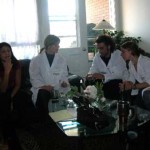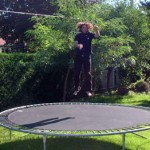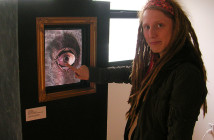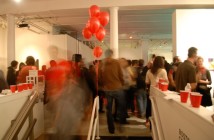I am a member of the Institute for Infinitely Small Things. Anyone can join. There is no secret handshake, no magic decoder rings, and no membership dues. Many different people have been involved at one point or another, people from all walks of life: artists, non-artists, students, architects, critics and just random people we have met on the street. Others participate online via the website. For several years, I have followed the adventures of iKatun at various exhibits, including the notable exhibit info@blah: overload and organization at The Boston Center for the Arts in 2003 and at performances the group has held throughout the country and internationally. To satisfy my curiosity as an artist/curator, I joined the group as part of The Institute for Infinitely Things and have been involved with several ongoing projects with the group. One of those projects is Corporate Commands, a project in which we gather commercial advertising instructions. These are then interpreted and performed as literally as possible at the site at which they are discovered.
Co-founders Kanarinka (Catherine D’Ignazio) and Pirun (Savic Rasovic) both worked together designing project management software for Fortune 500 companies at the height of the dot com boom in the late 1990’s and through that experience in the corporate world they began to work on the ideas of incorporating information systems and technology into art. This eventually became iKatun, which led to The Institute for Infinitely Small Things.
Jim: What were some of the projects and ideas that brought about the “Institute for Infinitely Small Things”?
Pirun: We studied and worked on several ideas for a long time. We wanted to use our skills and access to technology to see what would be possible. Using our experience and our informational and political backgrounds, we wanted to see what we could do in the arts with it.
Kanarinka: Early on there was a preoccupation with the politics of information. We were at the tail end of the dot com boom, where one could be an undergraduate, have no technical background and have no experience and no skills, but make $50, 000 a year. By that point, the economy was revealed to be a total sham. People were losing jobs and so forth. Working in the field of building software applications, there’s a whole politics of visibility: "What does it mean when the executive has total visibility in a company around the world and what are the implications of this? What does it mean in terms of structure and control?"
This led to our early idea for our Paradise project which adapted Dante’s Divine Comedy as a massive multimedia project centered around information instead of religion. Initially we presented it to Oni Gallery, which rejected the project.
Pirun: They wanted us to do something smaller. To do what we had originally envisioned would have cost $50,000. We allocated several months for building it and it would have been on the scale of a theme park. We needed 24 staff members to run it at all times.
Jim: And this project is what eventually evolved into "info@blah: overload and organization", an exhibition at the Boston Center for the Arts?
Kanarinka: We did realize the ‘Paradise’ portion of this project at in Fall 2002 at the BCA. So, Paradise was the idealized notion of information promoted by the whole dot com economy envisioned as an interactive installation. Then in Spring 2003, we translated some of the ideas about information and artists who use systems to display information and engage with the politics of information. That was how the info@blah: overload and organization show came about.
Pirun: It was also important to us to make a show that dealt with this contemporary issue of information and technology, digital technology specifically, but not concentrate on just on people who only use “high-tech” tools or “new” tools. Everyone has been affected by these changes so why not look at those artists who use the brush or the pencil but deal with the complexity of our present informational society.
An earlier project we did before, that is closer to what we are doing today, was a cross between Paradise and performance which was called †.com. We did a performance where we created a company where you could pray online, the idea was that if you could pray anywhere why not online? It was set up as a booth in the show “Iconoclasm”.
Kanarinka: It appropriated all of the language of the dot.com economy: “Spiritual management”, “prayer alignment” and so on…we were the “saints”, the mediums. This was for the show “Iconoclasm”, curated by KumaLisa at Harvard’s Adams House. We were set up as sponsors of the show, not participating artists, and posed as sales people at the site to promote our software. It all went over really well, people got mad at us.
Pirun: It wasn’t about religion at all, the whole point was not to ridicule religion but it this case it was all coming after the post collapse of the bubble of the 90s. There is this utopian notion that if you have information then all problems are solved. Well, not really, right? We are aware of that today more than we were 5 years ago.
Jim: What is the difference between iKatun and the Institute for Infinitely Small Things? And how do you view your roles as shifting between administrators, artists and curators in the group?
Kanarinka: We try to do be pretty fluid about it and not set up boundaries where “me as an artist stops here and now I am an administrator person”. That said, we do try to have some clear distinctions between what iKatun does and what the Institute does.
iKatun is more involved at an organizational and curatorial level. iKatun organizes conferences, but its also not purely administrative or curatorial because you can do those things in way that is also art. For example, a conference… like “The International Conference on Standing”, which iKatun is co-producing with Northeastern University’s Multimedia Studies Program in Spring 2007, will also be a work of art in itself. iKatun is more invested in dealing with multiple artists and multiple projects. iKatun does the work of carving out a territory and building communities in a particular space as opposed to doing a single project.
The Institute is more engaged with doing projects in public space or quasi-public spaces like malls. We go out and we do 57 Things to do for free in Harvard Square or our guidebook to Cambridge [entitled The Inconceivable Guide to Cambridge: 122 Maps to Places that You Would Never Find Otherwise]or we do performances of Corporate Commands. Its less about bringing people together and sharing information and experiencing each project and more about us doing those research projects and gathering the results.
Jim: How important is it that the two of you work in a group setting as opposed to working as individual artists?
Pirun: We have never thought of it as being just two people.
Kanarinka: iKatun translates to “temporary community”. Originally, we planned that iKatun would bring a certain group people together and then we would disperse as each project was ended. This was in counter to an organized collective where there is a fixed membership and everyone votes and its very democratic. With the two of us in iKatun, we are the ones who are there in between projects as the administrators, but every project involves more people than us and that’s the fun.
Pirun: This is where net art is important to me as a way of thinking about collaboration. It indicated that the best work you put out is the work that is put out by more than one person. This myth of the single, genius artist is bogus. There has always been collaboration between artists, artists of different callings. For example have you ever been involved with a theatre production -- was it one person or was it fifty people that made it happen? Was it because the capitalist society that only values a director and maybe a scriptwriter, that the director of the photography or the people who does the lighting or the costumes or the one who stands there coming up with ideas, don’t get enough credit? What if you are doing photos or a portrait? What is this object in the photo if not a collaborator?
We feel that the 90’s brought upon us this ability to communicate that was faster and more democratic because if you could gain an access you could get your word out, I repeat if you CAN get the access because that is still not democratic because you have to pay for it or access it somewhere.
Kanarinka: I would agree with that. We are always working to counter that myth of the artists as genius and the artist as sole-creator. I would like to situate our work directly as ”counter authorship” or something like that. It is a dialogue with the individualist model of how the art world works - which is a production of late-capitalist consumer society. Navigating and addressing authorship is important; it brings up an important philosophical and political question. It is extremely important that we work collectively. Its not just by accident or that we couldn’t hack it as individual artists.
Jim: So working in a group situation what happens to the ideas of authorship and individuality?
Kanarinka: Well, see Sasha is a communist so…
Pirun: No! NO! … I am not a communist! Far from it! I am obviously a capitalist. I live in a capitalist society; I enjoy the fruits of consumerism, and all I am saying is that I am ready to experiment with what I am used for, what I do, and how I am going to do it.
Kanarinka: It also comes down to these ideas that there is a single artist, is it true? I don’t believe in that. The idea that there is a singular artist and that art is about self-expression and your own individuality - These are really problematic notions. The idea that art should be about an expression of your own individuality sounds a lot to me like what Coke is telling you. Coke tells you to “Make it real” a fitness club tells you to “Be yourself only better” For me, I am supposed to have that same relationship with a corporation that I have with my artwork? I have a real problem with that. The myths of individuality, and originality, and authenticity are all emphasized by corporations as advertising constructions, to sell more products. It’s not just about artistic authorship, but the whole structure we are embedded in. It’s always political and always economic. What I see as the Institute’s mission is a way of engaging people in conversation , producing these strange situations and dealing with politics of everyday life. You pass by advertising telling you to do stuff every single day. You can say you have your blinders up but you don’t. The Institute performances don’t point at a command or try to “make the invisible visible”. We don’t try to convince others on the street that they should be activists against corporations. It’s important that we DON’T do that. We want people to use what were given in everyday life to start new conversations or think about a new way of inhabiting a public space such as with the “Roll Over ” (corporate command). We want to invent new ways of life and new ways of being social – if only temporarily.
Pirun: That’s important. You assume immunity to a lot of these messages and you are not immune, you’re a sponge. A sponge who is a statistic. A statistical sponge.
Jim: Part of the excitement of what we do, particularly with the Corporate Commands project is that we put ourselves in these unplanned, unscripted, and sometimes awkward situations but just like everything else in real life we have to get through it. Have there been any really surprising moments that stand out in your experiences in doing the corporate commands?
Pirun: It was surprising that we could perform for an hour and a half playing Chess in a mall (“Go Play” in front of the Gap in Copley Place Mall, Spring 2004). That to me was strange because another time in the same mall we got kicked out in 7 minutes. But we still went out for six hours after and really enjoyed ourselves anyways.
Kanarinka: Unexpected things happen every time. I don’t think there has been anything dramatically amazing because all of these things are all operating in everyday life. The situations usually stay at this level of the everyday, so, no - no one has come and beaten us up or anything.
Jim: One of my most memorable experiences with the Institute was last year, when we were in Montreal last year at the Artivistic festival, while researching the Corporate Command “Donnes-leur 4 heures pour vous sauver la vie” / “Give us four hours to save your life” We helped a French-Moroccan woman who had just broken up with her abusive boyfriend move out of their apartment and into her mothers place a few blocks away. There was a lot of tension because a lot of things there could have gone very wrong but in the end it all worked out.
Pirun: Well, to me, were not going to accept this scale that assumes in order for it to be important that it there has to be explosion that goes “BOOM!” -- it doesn’t work that way. This is everyday life. We helped someone move in to her apartment. She took us in for coffee and biscuits and stuff. As far as I am concerned that was a hell of a good day for me. I had never been to a Moroccan household so for that little trivial human reason I was very happy. And she smoked in her apartment, which made me even happier! To me those are really simple things that are more important than media spectacle or inordinate drama or someone collapsing a building in a city.
Jim: It is interesting how these simple things we participate in become a part of our everyday routine and how advertising and our experience with them has been absorbed into our systems, I mean how else did you come up with the number “57” for “57 things to do for free in Harvard Square?”
Kanarinka: It was a joke because I kept saying “57” sounded better than 58 for some reason because it was in my head. I thought of using “33” at some point as well.
Pirun: By the time we realized its connection it was too late to go back so we just left it.
Participate in projects with the Institute:
- Corporate Commands: Find, upload, map & suggest performances of corporate commands.
- Conflux 2006: Make a submission to Conflux 2006: Festival of Psychogeography (Deadline: April 10th).
- The Inconceivable Guide to Cambridge: 122 Maps to Places You Would Never Find Otherwise – The Institute will be staging mapping expeditions in each neighborhood of Cambridge during May – August 2006 in order to collect data for their new project, a tourist guidebook to the City of Cambridge.
- iKatun: Sign up for the iKatun/Institute mailing list.
All images are courtesy of the artists.







